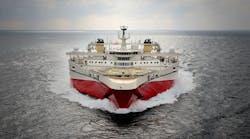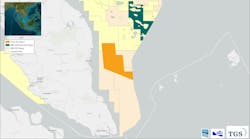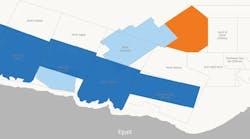Nicaragua's hydrocarbon activities have, until now, been conducted under a general resources law covering all extractive industries. Petroleum activity has been sporadic off both coasts with one main bout of exploration on the Caribbean shelf in the mid-1960s, during which 26 wells were drilled.
This exploration campaign established the presence of Eocene reservoirs with mature oil sources. Four wells were also drilled off the Pacific coast, leading to the identification of rich Upper Cretaceous source rocks with reservoir potential. Since the 1970s, activity has centered on regional studies of both petroliferous areas and the development of a separate legal regime for petroleum exploration and production.
Nicaragua's new petroleum legislation, Law No. 286, the Special Law for Exploration and Exploitation of Hydrocarbons and its Regulation, came into force in June 1998. This confirms ownership of all discovered hydrocarbons by the State and provides for a National Commission of Energy (CNE) to formulate the State's policy for hydrocarbons exploitation. The existing Instituto Nicaraguense de Energia (INE) will be responsible to CNE for supervising the direction of exploration and production activities. The intention is that exploration and production will be carried out under the provisions of the new law by independent companies under various forms of contract to the State.
2000 bidding round
The country now intends to hold its first bidding round for oil exploration contracts early in 2000, although no date has yet been announced. Matters under consideration include the areas to be offered for exploration and associated environmental restrictions.
In the area north of 14 degrees on the Caribbean shelf, there is already an environmental exclusion zone of approximately 4,190 sq km. Further restrictions may be declared, possibly related to near-shore and reef areas.
Assuming that exploration tracts are announced in the first quarter of 2000, submission of bids should ensue in the second quarter. Under the new legislation, INE will grant reconnaissance permits in non-contracted areas for a term of up to one year, under the terms and conditions established in the Regulation of the Law. The new Law also provides three contract modalities:
- Concession contract
- Production sharing contract
- Any other type of contract used by the petroleum industry.
Companies operating under any of these arrangements may be liable for area rentals and income tax. Exploitation rights will be for a 30-year period, with the possibility of a five-year extension. At the time of contract awards, there will also be a provision for objections by local authorities and individuals. Arrangements for environmental protection during petroleum operations must be agreed upon by the Ministry of Environment and Natural Resources (MARENA).
Geological analysis
Nicaragua has hydrocarbon-bearing basins on its east and west coasts. In both areas the basin development is almost entirely offshore. Both basins show evidence of migrated and trapped hydrocarbons.
On the Pacific Margin Basin, recent outcrop investigations have identified the presence of Upper Cretaceous source rocks with very high levels (10-55%) of types 1 and 2 kerogen in outcrop sections up to 120 meters thick. The rock is immature at outcrop, but the hydrocarbons generation is confirmed by onshore oil seeps. The four offshore wells drilled in the 1970s yielded some gas shows and porous clastic intervals. Good quality archive seismic and a 1990 survey by Western Geophysical also provided effective seismic coverage for structural control.
In the Caribbean Margin Basin, initial drilling was onshore during World War II. In the 1960s, 15 wells were drilled that confirmed the offshore extension of the Caribbean Basin and the presence of a Tertiary succession in excess of 3,000 m, with good quality carbonate and clastic reservoirs. One well, Perlas 1, tested oil at 350 b/d. Interest in the area revived in the 1970s with eight wells being drilled, two of which tested light oil.
Below the Tertiary, onshore at the Nicaragua/ Honduras border along the Coco river, a Cretaceous section outcrops. It is a massive rudistic carbonate bank (2,000 meters thick) with extensive oil staining at the top, which is overlain by bituminous shales and red beds. The upper parts of the Cretaceous succession are reported to have been encountered in Honduras during offshore drilling.
INE has a carefully archived set of well data and geological reports as well as around 30,000 km of seismic covering both basins. The age and quality of the seismic data is variable, especially for the Atlantic Margin, where much of it was recorded in localized areas to evaluate specific prospects.
Various research organizations have used the archive to make regional evaluations of the oil potential. In the Pacific in 1990, INE and Statoil carried out a basin study using good archive seismic and a purpose-recorded survey by Western Geophysical. Beicip in France has also compiled a general report on the archive data of the Caribbean Tertiary basin, covering structure, reservoir development, and hydrocarbons occurrence.
This year, Fugro-Geoteam completed acquisition of a 3,097 km seismic survey of the shallow shelf sea extending off the east coast to 82° west. This survey ties eight wells to provide regional stratigraphic and structural control across the shelf and into the deeper water of the Hess Escarpment to the southeast. Processed data has been available since September. More information about this project can be obtained from the author at Tel: (+47) 22-134695, Fax: (+47) 22-134646.






